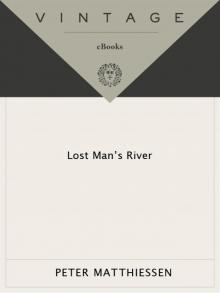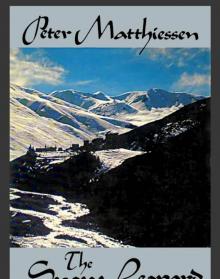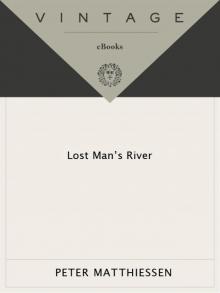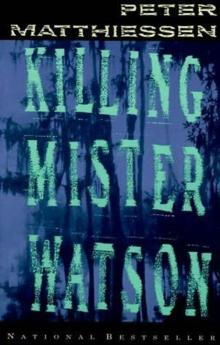- Home
- Peter Matthiessen
Men's Lives Page 6
Men's Lives Read online
Page 6
“Course everything changes, y’know. Was thinkin just the other day about chunks. A chunk was a heavy box, loaded around 350 pounds. Back before then we used sugar boxes, carry five—six hundred pounds, used to cart ’em up to the railroad and h’ist ’em up onto the cars. But the men could throw ’em around by hand, and the railroad men, too. Men these days gettin awful weak, seems like, because the boxes are gettin smaller all the time. After the chunks we had them shad boxes, with partitions, carried maybe 280; then there was a 200-pound box; then the 125-pound crate that we used in them years you was fishin with us. Now the wood boxes are all gone, they use them cardboard cartons, hold about 60–70 pounds apiece.”
During World War II, most of the few vehicles on the beach were Model A’s; the dories were still hauled down to the water on rollers. There was a night curfew on the beach, and because the “A’s” could carry no more than fifteen boxes, the Amagansett Coast Guardsmen sometimes helped with a late haul, to get the fishermen off the beach by dark.
“We never had no winch,” Bill says, “until right after World War II; Briggs and Stratton with 3:1 reduction gear, turnin a niggerhead on the bed of an old Army truck. That ain’t much different than what we got today.” After the war, converted weapons carriers and other vehicles with four-wheel drive rapidly replaced the tough old Model A’s and makeshift beach cars.
Even in the late forties, the bass runs were sporadic, and haul-seining was confined to six weeks in spring, six in the fall; in other seasons, the men set gill nets or went over to the bay. For eight or nine years in the 1940s, Bill Lester went beam-trawling for yellowtail flounder on the William D, from Montauk Point east to Noman’s Land, off Martha’s Vineyard, where a colony of Japanese fishermen was harvesting shark livers and fins for sharkfin soup; he recalls the colors of the rocks in the light of sunset at Gay Head, when the William D laid over in Menemsha, and the tepees of an Indian powwow on the shore. “We was rigged for swordfish, and one time we struck this one had a white scar on it, an old harpoon scar by the look of it, and Cap’n Bill Parsons sent me off in the dory to tend the keg. Well, this fish was some green, y’know, and damn if he don’t bang that sword up through the bottom of the boat, broke her off right into the coil of line between my boots! Next time he come up, I got a strap around his tail and just hung on. Wasn’t a dry spot on me but I held him—he never went down again.” One day Bill went out with Elisha Ammon, whose boat had vibrations that scared swordfish, but the William D “let you get fast to a fish; one year we seen just eighteen swordfish and we got ’em all.
“Back then somewheres, Frank bought the whole corner over here on the highway for $450, put gas pumps in there, called it the Amagansett Service Station. His wife had a little restaurant, made clam chowder, clam pies, sold a few cigars and knickknacks. Then she got sick and another feller had it; then Frank’s son-in-law took over, Brentford M. Bennett, called it Brent’s Store. And along there some time, Ted went into business, too.”
After World War II, Ted Lester had worked out of Montauk as captain of a private boat, the Pumpkin Seed, with his brother-in-law Vern Bennett as his mate. The owner gave him all the swordfish he could harpoon, and in the summer of 1945 Ted took fifty fish. In the same period, he invested in his own boat, a twenty-eight-foot Jersey skiff, the Sand Eel, which was run mostly by his brother Harry, assisted by another brother-in-law named Elmer Fenelon. Harry Lester, oldest of the “Posey Boys,” was already close to sixty, a small quiet man who made his living as a carpenter and house painter, but went back to the water whenever he could.
“End of the war,” says his brother Bill, “Ted got in with a rich feller down Montauk, ran his yacht for him, he did, and this man bought him that house down street there. Never could see yachtin myself, too much cleanin up after other people; come them little dewy nights, you had to wear tennis shoes and mop your decks up. But Ted done good with it. They was taking thirty-five–forty swordfish every summer, and Ted sold everything them people couldn’t eat. Took that money, y’know, and went in with Frank Tillotson, built that freezer under his house, 1947–48, called it Montauk Seafood.
“Frank Tillotson was from over Southampton way, and him and my brother Frank’s boys Harry and Robert, and Brent Bennett, them fellers was hand-linin sea bass off the wreck of the old Panther down off Shinnecock, and a big run o’striped bass come in, and they rigged a net, made a big haul—had to use town trucks to cart ’em all away! So we went west, got some of them fish, too. Why, in them days, we used to take our old cars all the way west to Tiana! [Hampton Bays-Quogue] Nowadays we got good trucks, but there’s too many people on the beach and not enough fish, so we don’t go nowheres.”
5.
In Bonac:
Clammers and Scallopers
In 1684 the East Hampton Town Trustees sent sixteen men to Meantecut to help the Indians open the tidal creek from the bay into Montauk Great Pond, apparently to revive its oyster beds with more salt water. Big local oysters, often a foot long, were a basic food of both Indians and settlers, and because—unlike fish—they could survive the sea voyage to market in New England and New York, oysters, like clams, were harvested for export as well as for extensive local use.
In the 1700s an immense oyster bed was located to the west, off Blue Point, on the Great South Bay, attracting an ever-increasing group of men “who depended for their subsistence upon the products of the waters of the bay. They were called baymen. For nine months the baymen lived on the profits derived from the oyster beds, and depended upon the other three for clamming and fishing. They were poor for the most part, but independent.”1 Working from small catboats, sloops, and the flat-bottomed sharp-prowed work skiff called the sharpie, the baymen harvested these beds with tongs, and by the early nineteenth century had all but exhausted the Blue Point field. But oyster packing houses in Patchogue continued to buy oysters taken elsewhere on Great South Bay, which were shipped in kegs to New York’s Fulton Fish Market. In the 1860s, when oyster tongs were replaced by the dredge, the last beds were already overfished, and soon the independent baymen were put out of business by large companies that planted oysters on prepared grounds and saw to it that the use of dredges was outlawed elsewhere.
On the South Fork, where the salt ponds and harbors were once crusted with wild oysters, this fishery had been domesticated, too. In 1831 Isaac Van Scoy of Northwest received permission from the East Hampton Town trustees to plant an oyster bed in Northwest Creek, and by century’s end large oyster operations based in Greenport were laying beds in Peconic and Gardiners Bays; the “Gardiners Bay salt” challenged the Blue Point as a celebrated oyster in the city markets. By 1900, the last wild oysters were old lone “coonfoots” on rocky bottoms avoided by the scallopers and clammers. All that remained of this great public fishery was the name “baymen,” which had spread eastward with the refugee fishing families from Great South Bay. The heretofore independent baymen were reduced to dredging jingle shell cultch2 for the privately owned oyster beds, and even today, the few oysters taken by the baymen are mostly sold as seed stock to the corporations.
One of the best oyster grounds in the whole township was Accabonac Creek, a few miles northeast of East Hampton village. In the early fifties, when I first came there to live, the Springs, or Bonac, was mostly farmland owned by Bennetts, Talmages, and Millers, sloping down across the tidewater to Bonac Creek; at the head of the creek was a community building and a gas pump and general store. Originally the main source for salt hay for the settlers’ stock, Bonac Creek was a peaceful and very pretty place of meadowland and cedar fields and a quiet lead of water, widening out eastward past Tick Island to the sand spit at Louse Point and Gardiners Bay.
This backwater had changed very little in the long slow decades since the turn of the century, when the Wood family arrived here from the Great South Bay, one of the first fishing families (they are still coming) to be driven eastward by the destruction of the fisheries farther west. “They were clam and oystermen, they h
ad sloops, and they went clammin in the ocean, and flounder fishin, eelin,” says Jarvis Wood, born in the Springs in 1908, and they were baymen (although Jarvie says that this name did not come into general use out here until recent decades). “My grandfather, he fished all the time, he was a fisherman all his life. And my father was a fisherman, only thing he ever done. So naturally I started, I come fishin, too.”
At the creek head (still called Pussy’s Pond after an old Miss Pussy Parsons) the Parsons oyster house, used for opening scallops “after the oysters run out,” later became Smith’s general store, where storytelling took place every Sunday evening. In the twenties, dances were held there once a week. The two churches were Episcopal and Presbyterian, divorce and unwed couples were still scandalous, and old people without furnaces or relatives went to the poorhouse thirty or forty miles “up-Island” (Jarvie’s father-in-law was Overseer of the Poor). For many years his mother took in laundry for the summer people in East Hampton, which had turned from a farming-fishing town to a resort by the turn of the century.
“Nobody was in a real rush to do anything, they didn’t need all this money, all this stuff to go to, all they wanted was to make a livin. Everybody was fishin or farmers; s’all there was. Either go fishin or farmin, and a lot of the farmers went fishin. In the summertime, when they had their crops in, they’d go down clammin; in the wintertime, when their crops are gone, they go scallopin, oysterin. Everybody got along, y’know, they had taters in the cellar, maybe a barrel of pork, something like that; no one went hungry.
“In them days, fishin wasn’t so easy as it is today. Today you got trucks and motors, you got everything to do all your work with; them days, you done all your work with your hands. If you wanted to go somewhere you took a pair of oars and you rowed your boat; you didn’t just steer a boat, go down where you wanted to fish! But flounders, used to be so many in the bay, if you set a fyke out you couldn’t even get ’em in, there was too much in the fyke. Then all of a sudden they disappeared, couldn’t get no flounders, everybody went out of business. Then they come back again, though there ain’t as many as there used to be cause of the draggers.”
As a small boy, Jarvie lived at Lazy Point in Napeague, where his family were clammers and dug skimmers for the cod trawls in the ocean; he remembers that eels were collected in a barrel until some “backer” (tobacco) was tossed in to stun the slippery creatures before attempting to “skun ’em out.” (Some baymen put ashes on their hands for “sloimin,” others use burlap bags to grasp the eel, which is fixed by the head on a nail stuck through a wall; the throat is then cut through the bone, and a slit made down the length of the belly, after which the head and skin are stripped away.) For a time he worked on “Old Man Schellinger’s” farm, one of many in the neighborhood that raised chickens and corn and wheat. But Jarvie quit high school after a year to become a fisherman.
“If we wanted eels or clams or fish, we always got ’em fresh, cause there was no problems gettin stuff to eat. In the wintertime we used to shoot ducks. Them days people didn’t kill themselves like they do t’day, cause there was no problems. Whatever you want’d to catch, there was plenty of it. You go out and catch a couple bushel clams, if you was ambitious three bushel; man had a big family, he had to work harder. Any time you didn’t have nothin to do, you’d go out clammin.”
Quahogs, or hard clams (in market terms—in ascending size—littlenecks, cherrystones, and chowders) have been a Long Island subsistence food since prehistoric times. The Indians used the purple and white interior for wampum, and the strong valves served very well as hoe blades. Even today the hard clam is the most dependable of all the fisheries, between seasons, in winter, and when times are poor. (Soft clams, or steamers—known to the commercial men as piss clams because of the jets of water they emit in times of stress—are dug from soft mud flats with a clam hook, like a short forked hoe, or “grinded” in shallow water by an outboard propeller that spins the clams up to the surface. Like the long clam (surf clam or skimmer)—the big clam cast up on the ocean beach in storms and used as ashtrays in the summer cottages that began to turn up on the dunes in the 1880s—soft clams were considered unworthy of human consumption in the early days, and were mainly harvested for cod bait, hog and poultry food, or fertilizer. The common blue mussel and the whelk, or winkle, once so sought after for wampum, were ignored. Today steamers, winkles, and mussels are much in demand, and the fried clam served in summer restaurants is usually the lowly skimmer.)
Hard clams are mostly taken with a scratch rake fitted out with an iron basket. A longer and larger rake with back strap and crossbar pull handle, called the bull rake, is often used by the commercial men in deeper water.3 In winter the bayman may resort to long-poled double-basket rakes in the form of pincers, worked from a small boat and known as tongs. Whatever the implement, even when hard clams were common, the average bayman rarely took more than five bushels on a tide (although Bill Lester, in his days on Montauk Lake, took six or seven). Now the clams have been overharvested. The three-bushel limit is hard to achieve, and its value varies: chowder clams may be worth just five dollars a bushel, whereas cherrystones—five for a penny at the turn of the century—may sell for fifty dollars a bushel, sometimes more. Especially on rocky bottoms (and also in winter, when the sand is hard and dense, and the clams are deeper) clams are much more work for a lot less money than the free-swimming scallops, which in most years support a very profitable local fishery.
In the Depression, as Captain Nathan Lester told the Island News in 1933, it was “pretty hard to make a decent living fishing.” Like many baymen, Jarvie Wood tried work at regular jobs, returning to fishing about 1940. In the early fifties, when I lived in the Springs, he had opened a small store near his Neck Path house, on the road to Amagansett, but in 1964 he sold the store and returned to fishing once again. “Was makin some good money, too,” he told me twenty years later. “But I said to my wife, ‘What we ever goin to do with all that money? Get to be old, y’know, ain’t nothin much you want to do anyway.’ She didn’t want to sell but she agreed to it, just to go along with me.”
In the early fifties the Springs was still back in the woods, and rents were very inexpensive. My friend John Cole lived in the old Parsons house across from the old school and Pete Scott lived in a small cottage on the salt marsh. (During World War II, on visits to East Hampton, I had become friends with John’s family, and sometimes, as a friend of Pete Scott’s brother, I had stayed in the Scott cottage, called the Box, a very old house near “Home Sweet Home” on East Hampton’s Main Street.) With my wife and infant son, I found a cottage on Fireplace Road just west of the horse and cattle farm of George Sid Miller. In those days there were few writers in the region, and apart from the Coles and Scotts, most of the people that we saw were painters. Francile and Sherry Lord, Lee and Jackson Pollock, Charlotte and Jim Brooks were neighbors as well as friends, and many other painters lived not far away, with more still coming. To the local people, all of us were “people from away,” the forerunners of many still to come. (As Milt Miller says, “I always thought of all outsiders as foreigners—still do, I guess.”)
The fall of 1953 was my first season clamming and scalloping in Three Mile and Northwest Harbors. My fishing partner was John Cole (who like myself was unsuited to urban work and had sought a leaner way of life outdoors) and our scallop boat was a nineteen-foot double-ended Quebec codfish boat with a short mast and a one-cylinder engine (hence her name, Vop-Vop) which, in size and sound, if not in her appearance, must have reminded the old-timers of the first Jersey boats launched through the surf. Rigged out with culling board and scallop dredges, the Vop was moored in a small anchorage just north of Emerson Taber’s lobster dock in Three Mile Harbor—the Town Commercial Dock site, given to East Hampton by the Gardiner family back in the thirties. On the still warm Indian summer days of mid-September, no dredges or culling board were necessary; we drifted the broad harbor flats south of the long neck called Sammis Beach,4
pouring a little bunker oil upwind to smooth and clear the surface of the water and using the rim of long-poled dip nets to tap the edges of somnolent scallops in their sand nests in the eelgrass, causing them to somersault backward into the mesh.
The delicious inshore pecten, or bay scallop, was regarded with suspicion by the early settlers. Scallop shells abound in the Indian middens, but the creature’s lurid interior design, set off by a mantle of phosphorescent turquoise, was apparently not approved by local Puritans, especially when plainer shellfish were so plentiful. Even a cat, it was related, might discover that its tail had fallen off after eating a scallop. This peculiar species was a free-swimmer, not easily confined to domestic beds; unlike more stick-in-the-mud mollusks, it was able and ready to rise up from the bottom and jet through the water by opening and shutting its valves, and might gallivant “down bay” for a considerable distance before this errant impulse had subsided.
But if the settlers were conservative, they were also practical. Local opinion of the scallop changed in the middle of the nineteenth century—or so it is said—when an enterprising fisherman from Connecticut did very well with a cargo of scallops from Peconic Bay, inspiring a beached whaleman of Sag Harbor to develop a small market for this seafood in New York City. With the appropriation of the oyster industry by private interests, the desperate baymen flocked to the new fishery, and by 1873, five thousand bushels were taken in one season from Peconic. Old discarded oyster dredges worked well with scallops, which would flip upward in a backward somersault into the wide mouth of the oncoming dredge, and almost any small craft, rowed or sailed, would suit the purpose. By the turn of the century, two hundred small boats were engaged in scalloping.

 Lost Man's River: Shadow Country Trilogy
Lost Man's River: Shadow Country Trilogy The Tree Where Man Was Born
The Tree Where Man Was Born The Snow leopard
The Snow leopard Sand Rivers
Sand Rivers The Cloud Forest
The Cloud Forest Sal Si Puedes (Escape if You Can)
Sal Si Puedes (Escape if You Can) Far Tortuga
Far Tortuga Men's Lives
Men's Lives On the River Styx: And Other Stories
On the River Styx: And Other Stories Shadow Country
Shadow Country At Play in the Fields of the Lord
At Play in the Fields of the Lord Lost Man's River
Lost Man's River Killing Mister Watson
Killing Mister Watson On the River Styx
On the River Styx